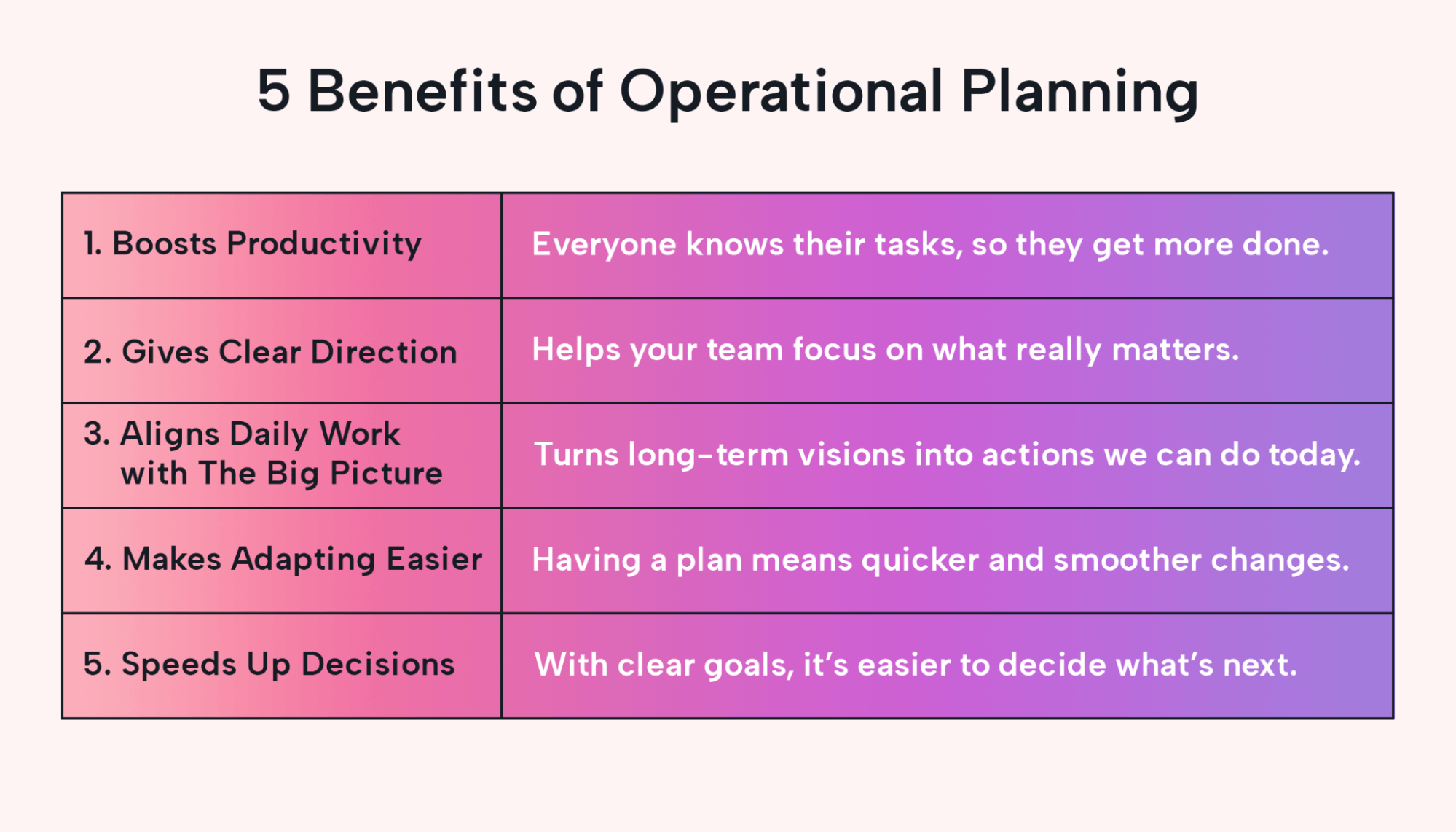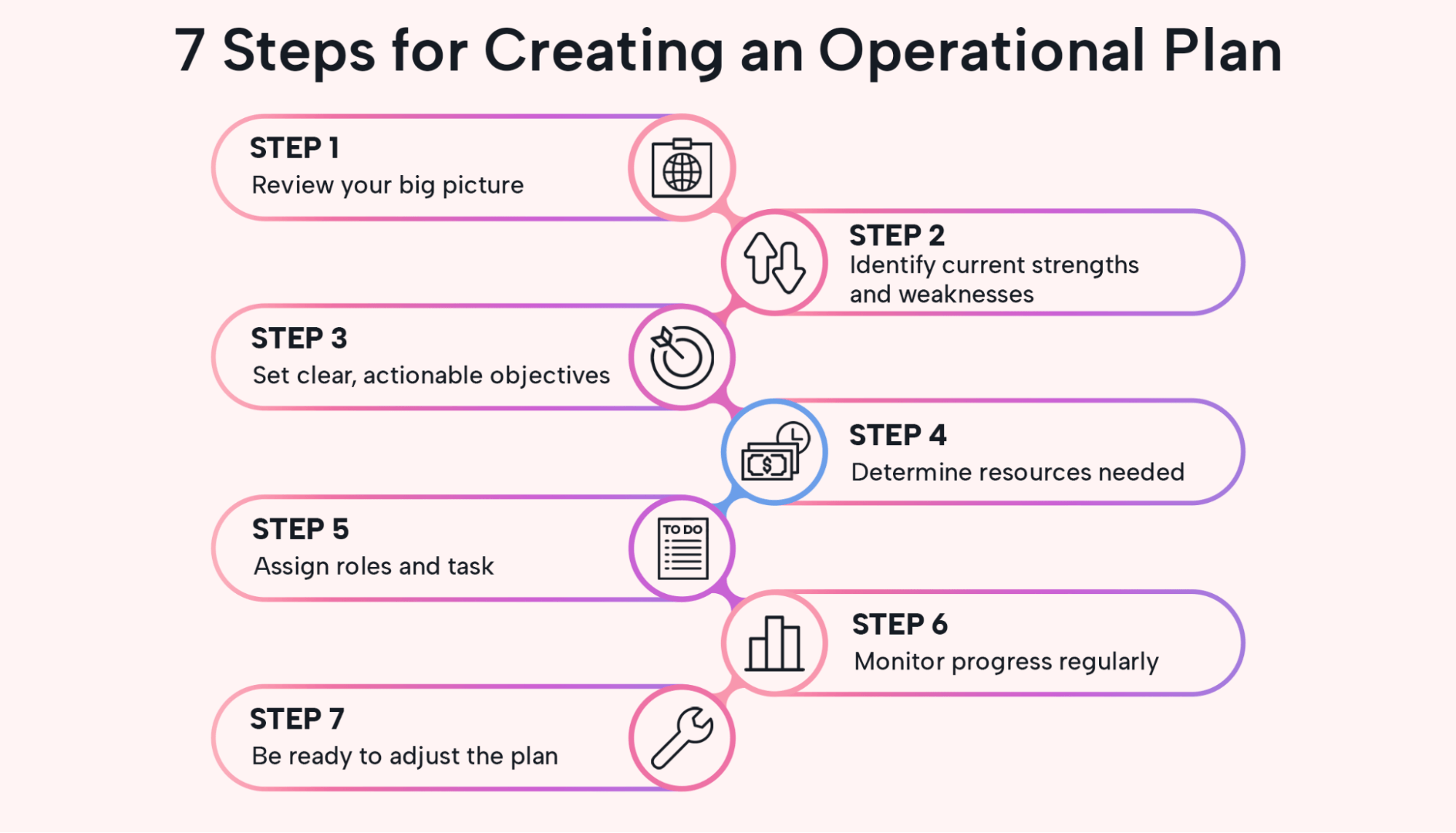Every business owner dreams of success. But without a clear roadmap, even the hardest workers can get lost in the shuffle of daily tasks, losing sight of their grand ambitions.
Operational planning is that roadmap, breaking down lofty goals into actionable steps. It’s not just about working hard — it’s about working smart.
Dive into this guide as we dissect operational planning and show how it can propel your business toward its next significant milestone.
What is operational planning?
Operational planning is about making detailed plans for achieving short-term goals, usually within a year. It turns big strategies into specific tasks and steps that teams can follow.
For example, a store might have an operational plan for the holiday season that includes sales targets and staffing schedules.
This kind of planning helps everyone know what they need to do and ensures that resources are used effectively.
It’s like creating a detailed map for a journey, making sure the ship stays on course and reaches its destination smoothly.
Operational planning is essential because it directly helps an organization reach its bigger goals, even though it might seem like a small part of the process.
What’s the difference between an operational plan and a strategic plan?
An operational plan is a short-term, detailed guide for day-to-day work, aiming to reach goals within a year. It's like a specific recipe you follow to cook a meal.
On the other hand, a strategic plan sets long-term company goals for the next three to five years, giving the big picture of what you want to achieve, similar to planning a menu for a week.
The operational plan shows the steps (how and when), while the strategic plan shows the overall goals (what and why).
Understanding the difference between operational and strategic planning helps you (and your team) use time and resources wisely, keeps everyone on the same page, and ensures that every small task inches you closer to your bigger goals.
Why operational planning is so important for your business
Enhances team productivity
Operational planning helps everyone know what to do, stay excited about their work, and focus on important tasks, making the whole team work better.
Operational planning helps achieve this by:
- Establishing clear roles: Everyone knows exactly what their job is, what their key performance indicators are, and what results they’re expected to deliver
- Motivating through clarity: Having clear goals helps everyone feel more ready and eager to work.
- Identifying levers: Everyone works on what’s most important — the “levers” that make big impacts — rather than “putting their time in”on bootless tasks.
This way, operational planning guides every team member in contributing effectively, enhancing overall productivity.
Provides clarity and direction
A good operational plan shows the best way to use time and money and lays a clear path for the team.
It does this through:
- Smart use of resources: A solid operational plan makes sure that time and money are spent on the most important things.
- Knowing what’s important: Prioritization helps teams focus on the big tasks first.
- Removing the guesswork: Make sure everyone knows the plan and follows it.
These elements work together to guide the team towards achieving their goals efficiently.
 |
Secures alignment with strategic objectives and goals
Operational planning connects everyday tasks to the company’s big organizational goals, helps check progress, and keeps everyone working together towards the same aim.
It accomplishes this by:
- Connecting daily activities to big ideas: 41% of US workers aren’t sure what their organizational purpose is. So, establishing this connection shows how every task helps achieve the main goals.
- Regular check-ins: These let the team check if they’re on the right path and make changes if needed.
- One shared goal: A unified front keeps everyone working towards the company’s primary aim.
This alignment keeps everyone moving in the same direction, ensuring all the work contributes to the business’s success.
Boosts business flexibility
A strong operational plan prepares your business for sudden changes, helps plan for possible challenges, and lets leaders make quick decisions.
Operational planning shapes this adaptability through the following:
- Preparing for surprises: “Expecting the unexpected” helps the business adjust quickly when these unexpected things happen.
- Nurturing a problem-solving mindset: By thinking about what problems threaten the business, teams nurture problem-solving skills, leading to better decision-making.
- Quick decisions: Operational planning helps leaders make fast and informed choices. Being flexible like this is key to staying strong and ready for anything in business.
Each of these elements helps your business survive in the face of uncertainty and become more resilient to unexpected threats.
Streamlines decision-making
Operational planning makes decision-making easier by using facts, clear steps, and setting priorities to guide choices.
Operational planning supports this by:
- Helping you make choices based on facts: Operational planning ensures that decisions are based on real information, not just feelings.
- Establishing clear procedures: A clear plan defines steps for various processes so that you’re not shooting from the hip, hoping you’ll do things right.
- Fewer arguments: With clear priorities, there's less disagreement on what to do next, saving time, money, and the sanity of everyone on the team.
The bottom line is that by streamlining decision-making in this way, operational planning helps the business navigate challenges and seize opportunities effectively.
Challenges of operational planning
Operational planning is essential for a business’s success, but it’s not without challenges. Let’s break these down to understand them better.
Balancing today's work with tomorrow's goals
It’s tough to manage daily tasks while also thinking about the future. Imagine a juggler trying to keep several balls in the air at once. If they focus too much on one ball, the others might drop.
In business, concentrating only on today's work can cause us to lose sight of our long-term goals.
And deciding whether to spend our time and money now or save it for later can be tricky. It’s like being at a crossroads and needing to choose the right path that leads to growth and success.
Gathering reliable information
Today, we have more information at our fingertips than ever before. But this can be overwhelming. It’s like trying to drink water from a fire hose – too much too fast.
It's challenging to know what information is important and what isn't. For example, a business might have a lot of customer feedback, but figuring out which comments will help improve the product can be hard.
And because the business world moves so quickly, using old information can lead to mistakes. It’s like trying to hit a moving target using an outdated map.
Keeping your team aligned
Making sure everyone on a team understands and follows the plan can be like herding cats. Even with clear instructions, people might need clarification. And some might not want to change the way they work, even if it’s for the better.
It’s essential to keep everyone on the same page and moving in the same direction. Think of it as a boat crew rowing together; if everyone is in sync, the boat moves smoothly. But if not, it can be a bumpy ride.
The bottom line is that operational planning is key to a business’s growth, but it has its hurdles.
Balancing daily work with future plans, finding the correct information, and aligning the team are all “mission critical.”
Tackling these challenges head-on can lead to a smoother journey and a brighter future for the business.
How to create an operational plan
Creating your operational plan requires a systematic approach so that you cover all the bases to set your business on a path to achieve its goals.
Here’s a step-by-step guide to help you through the process.
Step 1: Review your big picture
Start by taking a step back and looking at the overarching goals of your business. What are the main objectives you want to achieve in the next year or even five years? These could range from increasing revenue and expanding market share to improving customer satisfaction.
Step 2: Identify current strengths and weaknesses
Once you have a clear understanding of your long-term goals, it’s time to assess your current situation. Conducting a SWOT analysis can be a helpful tool here. This involves identifying your business’s strengths, weaknesses, opportunities, and threats. It’s about understanding what you’re doing well, where you could improve, and what external factors might impact your business.
Step 3: Set clear, actionable objectives
With your SWOT analysis in hand, you can now set specific short-term targets that will help you achieve your long-term goals. Make sure these targets are SMART – Specific, Measurable, Achievable, Relevant, and Time-bound. For example, instead of setting a vague goal like "increase sales," a SMART goal would be "increase sales by 10% in the next quarter."
 |
Step 4: Determine resources needed
Next, list out all the resources you will need to achieve your objectives. This could include money, staff, equipment, and more. Also, plan how you will secure these resources. It might involve hiring new staff, purchasing equipment, or reallocating existing resources.
Step 5: Assign roles and tasks
Clearly define who in your team is responsible for what. Make sure every member knows their specific duties and the deadlines associated with them. This helps in ensuring accountability and that everyone is on the same page.
Step 6: Monitor progress regularly
Set up regular check-ins, whether weekly, monthly, or quarterly, to track the progress of your operational plan. Use these sessions to identify issues, address problems, and make necessary adjustments to stay on track.
Step 7: Be ready to adjust the plan
Finally, understand that no plan is perfect from the get-go. Be flexible and open to making changes based on the feedback you receive and the results you observe. The business environment is always changing, and your operational plan should be adaptable enough to change with it.
By following these steps, you create a solid foundation for your business to achieve its strategic initiatives, ensuring you are prepared for the journey ahead.
Examples of operational plans
Next, we'll go through practical examples to show you how operational plans work in real-life situations.
You'll see the steps involved and understand how these plans help businesses achieve their goals.
By looking at these examples, you'll get a clearer idea of how to apply operational planning to different scenarios.
Example 1: A gym aiming to boost membership rates
Suppose we have a local gym aiming to boost membership by introducing new fitness classes.
Step 1: Review your big picture
- Goal: Increase gym memberships by 15% by launching three new fitness classes within the next six months.
Step 2: Identify current strengths and weaknesses
- Strength: Loyal member base and knowledge of their fitness preferences.
- Weakness: Limited space in the gym and lack of instructors for specialized classes.
Step 3: Set clear, actionable objectives
- Objective: Research popular fitness trends, hire or train instructors, and set up class schedules in 5 months. Dedicate one month for promotion to attract new members.
Step 4: Determine resources needed
- Need: Equipment for the new classes, trained instructors, and promotional materials to entice new sign-ups.
Step 5: Assign roles and tasks
- Manager to research and decide on the new classes.
- HR to recruit or train instructors.
- Marketing team (or person) to create a campaign that highlights the new classes and appeals to potential members.
Step 6: Monitor progress regularly
- Bi-weekly meetings to check on class setup progress and track membership sign-up rates.
Step 7: Be ready to adjust the plan
- If the classes aren't drawing in the expected number of new members, consider offering promotions, adjusting class times, or exploring different class types.
Example 2: A local bookstore aiming to increase sales
Suppose there’s a local bookstore that wants to increase book sales by hosting monthly themed events.
Step 1: Review your big picture
- Goal: Boost monthly sales by 20% by hosting themed events over the next six months.
Step 2: Identify current strengths and weaknesses
- Strength: Well-curated book selection and a cozy venue that's popular for gatherings.
- Weakness: Limited marketing experience and budget constraints for organizing larger events.
Step 3: Set clear, actionable objectives
- Objective: Identify and organize one themed event per month that resonates with the community, driving both event attendance and book sales.
Step 4: Determine resources needed
- Need: Event materials, possible guest speakers or performers, promotional flyers, and online ads.
Step 5: Assign roles and tasks
- Store owner to select monthly themes and potential books to highlight.
- Staff members to handle event logistics like setting up, decorating, and coordinating with guest speakers.
- A dedicated person (or outsourced help) to manage promotion, both in-store and online.
Step 6: Monitor progress regularly
- Post-event reviews to measure attendance, book sales during the event, and gather attendee feedback for future improvements.
Step 7: Be ready to adjust the plan
- If an event theme doesn't mesh with customers or fails to boost sales as expected, brainstorm new themes, adjust marketing strategies, or consider partnerships with local businesses for joint events.
How Motion helps your operational planning
Efficient operational planning is key in the fast-paced business world, and Motion is here to streamline that process.
AI-powered scheduling adapts to changes, keeping your business on track
Motion’s AI-powered scheduling plans your day, ensuring nothing is missed by rescheduling uncompleted tasks. This feature helps you focus on priority tasks adapting to real-time changes.
Project oversight keeps the team together and in the know
Motion provides a clear overview of all team tasks, reducing the need for constant check-ins and enhancing communication. Tasks are sorted by priority, deadlines, and dependencies, aligning the team towards common goals.
Unified work management keeps tasks organized in one spot, making work smoother.
Motion consolidates to-dos, calendars, and tasks in one place, streamlining your workflow. It ranks tasks by importance and alerts you to deadlines, helping you manage your time effectively.
By integrating Motion into your operational planning, your business gains a tool that promotes efficiency, clarity, and focus, transforming operational planning into a strategic advantage.
Master operational planning with Motion
Planning is key, but with Motion, it's a breeze.
Want smoother workflows and better results?
See how it can refine your operational planning and execution, making tasks simpler and your business stronger.







